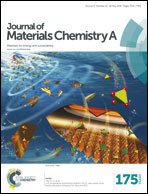An amphiphilic block–graft copolymer electrolyte: synthesis, nanostructure, and use in solid-state flexible supercapacitors†
Abstract
We report a highly ionic conductive amphiphilic nanostructured polymer electrolyte with good flexibility for solid-state flexible supercapacitors. It is based on a block–graft copolymer, i.e., poly(styrene-b-butadiene-b-styrene)-g-poly(oxyethylene methacrylate) (SBS-g-POEM) synthesized via one-pot free-radical polymerization. The SBS-g-POEM comprises hydrophobic SBS main chains and hydrophilic POEM side chains, providing mechanical strength and ion conducting properties, respectively. Preferential interactions of POEM with a salt and the morphological evolution of SBS-g-POEM electrolytes were demonstrated. A well-defined microphase-separated structure with good interconnectivity at the nanoscale was observed. This is responsible for the high ionic conductivity of the electrolyte together with the dimensional stability. A detailed structure–property relationship was investigated by changing the ratio of SBS to POEM, the concentration of each component, the chain length of POEM, and the operating temperature. Furthermore, solid-state flexible supercapacitors were fabricated using carbon-based electrodes on carbon paper substrates. The performance of supercapacitors based on the SBS-g-POEM electrolyte was much higher than that of the widely used conventional PVA/H3PO4 electrolyte.


 Please wait while we load your content...
Please wait while we load your content...